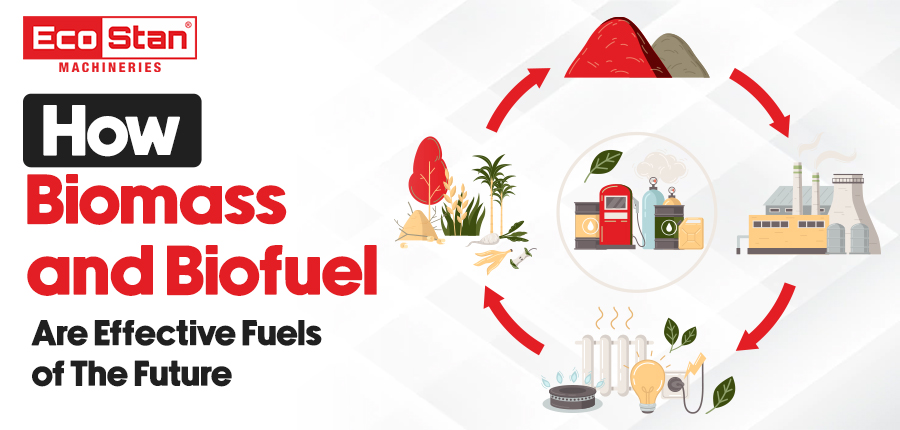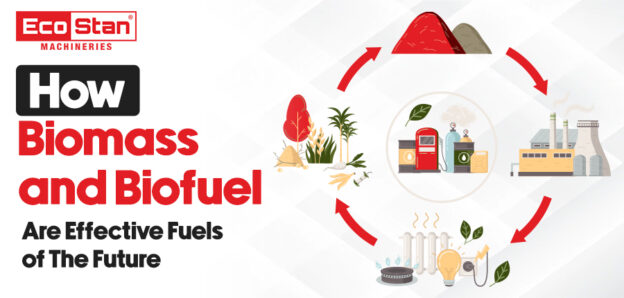ECOSTAN® How Biomass and Biofuel are Effective Fuels of The Future

Biomass energy and biogas are both forms of renewable energy that are carbon-neutral biofuels. Biomass can come from various sources, including crops, wood, animal residues, and other industrial byproducts that would otherwise be discarded in landfills or openly burned. To make biomass a usable kind of energy, you should dry it first using a biomass dryer in order to decrease the moisture content, lighten its mass and make it easier to store and transport.
You can burn the leftover branches that are of no use, creating energy from biomass fuel. You get the Biomass fuel from organic matter, including plants and animals. One of the most significant benefits of biomass energy or biofuels is carbon neutral, as the CO2 has already been extracted during the organism’s life cycle. Therefore, burning it does not produce any additional CO2 emissions. To understand it more deeply, take an example of a tree. Trees require CO2 to produce oxygen through photosynthesis, and they absorb CO2 already in the atmosphere. When you burn the tree, there is a release of CO2 back into the environment in oxygen exchange, which fuels the fire. As a result of this process, there is no net increase in atmospheric CO2.
You can obtain Biomass energy through various methods, all involving utilizing natural sources. One approach involves utilizing waste products from forestry operations. When forestry companies harvest the trees, certain parts of the tree are not of any use. Branches, rotten wood, and leaves will be waste materials that you can repurpose. You can produce biomass energy by crushing these byproducts and sending them to a biomass power plant. Another way to obtain biomass energy is by growing specific crops for that purpose. For instance, rapeseed, corn, and sugarcane can be grown and harvested for biomass energy production.
How can you Generate Energy from Biomass?
You can use a Biomass briquette machine, a mechanical device, to make biomass briquettes from biomass waste, such as wood chips, sawdust, straw, rice husk, peanut shells, and other agricultural product waste. The machine compresses the biomass waste into briquettes of different sizes and shapes, which later you can use as a biomass energy fuel source for cooking, heating, or as a substitute for traditional fossil fuels. Biomass briquettes are an eco-friendly alternative to traditional fuels like coal and wood.
Biomass energy power plants are facilities to generate electricity or heat by burning biomass, which refers to organic matter from plants and animals. Biomass can be wood chips, sawdust, agricultural waste, municipal solid waste, and more. Burning biomass converts water to steam, which you can use to generate electricity or provide heat for buildings. Before burning biomass, it has to dry completely; for that, you can use a biomass dryer. There are various methods by which you can burn biomass to produce energy. You can burn it directly in a boiler to create steam that drives a turbine, generating electricity. Alternatively, one can convert it into a gas called biogas through a process known as anaerobic digestion, which involves breaking down organic matter in the absence of oxygen. Biogas can then be burned to produce electricity or heat.
Biomass can convert into biofuels like ethanol or biodiesel, besides direct burning and biogas production. Manufacturers chemically process vegetable oils (rapeseed oil) or animal fats to remove impurities and increase their energy content, producing biodiesel as a renewable fuel. Biodiesel, which produces lower emissions than traditional diesel, can substitute petroleum-based diesel fuel in diesel engines.
Advantages of using biomass as your biofuel:
Biomass is any organic material from plants and animals, such as wood, crops, and waste products.
Here are some benefits of using biomass as biofuel:
Renewable and Sustainable: Biomass is a renewable and sustainable source of energy. As long as plants and waste products are produced, biomass will always be available. Biomass is an inexhaustible source of energy because it can be regenerated over time, unlike finite fossil fuels.
Reduces Carbon Emissions: Biomass is a low-carbon fuel that emits fewer greenhouse gases than fossil fuels. Burning biomass releases carbon dioxide (CO2), but plants absorb this CO2 during photosynthesis, and biomass energy becomes a carbon-neutral energy source. But ensure you dry biomass properly with a biomass dryer before burning it as fuel.
Supports Agriculture: Agricultural waste products are the major source of biomass, such as corn stover, sugarcane bagasse, and wheat straw. Farmers can generate additional income and reduce waste disposal costs by using these waste products as biofuel.
Improves Energy Security: You can produce Biomass energy domestically, which reduces dependence on foreign oil and improves energy security. This can help stabilize energy prices and reduce the risk of supply disruptions.
Diverse Applications: You can use biomass for a variety of applications, that includes electricity generation, heating and cooling, and transportation fuels. You can also use a biomass briquette machine to make briquettes ideal for cooking. This versatility makes biomass a valuable resource that one can use in many different ways.
Conclusion:
We can transition to sustainable energy production with a greener future in mind. Smart solutions have made renewable energy sources an appealing alternative to traditional ones. Biofuels or biomass energy are ideal for a step towards a more sustainable future. When considering investment options, biomass dryers and biomass briquette machines are great choices. If you’re looking to purchase a biomass briquette machine or biomass dryer of exceptional quality, Ecostan is the place to go.


 Click to Play Video
Click to Play Video